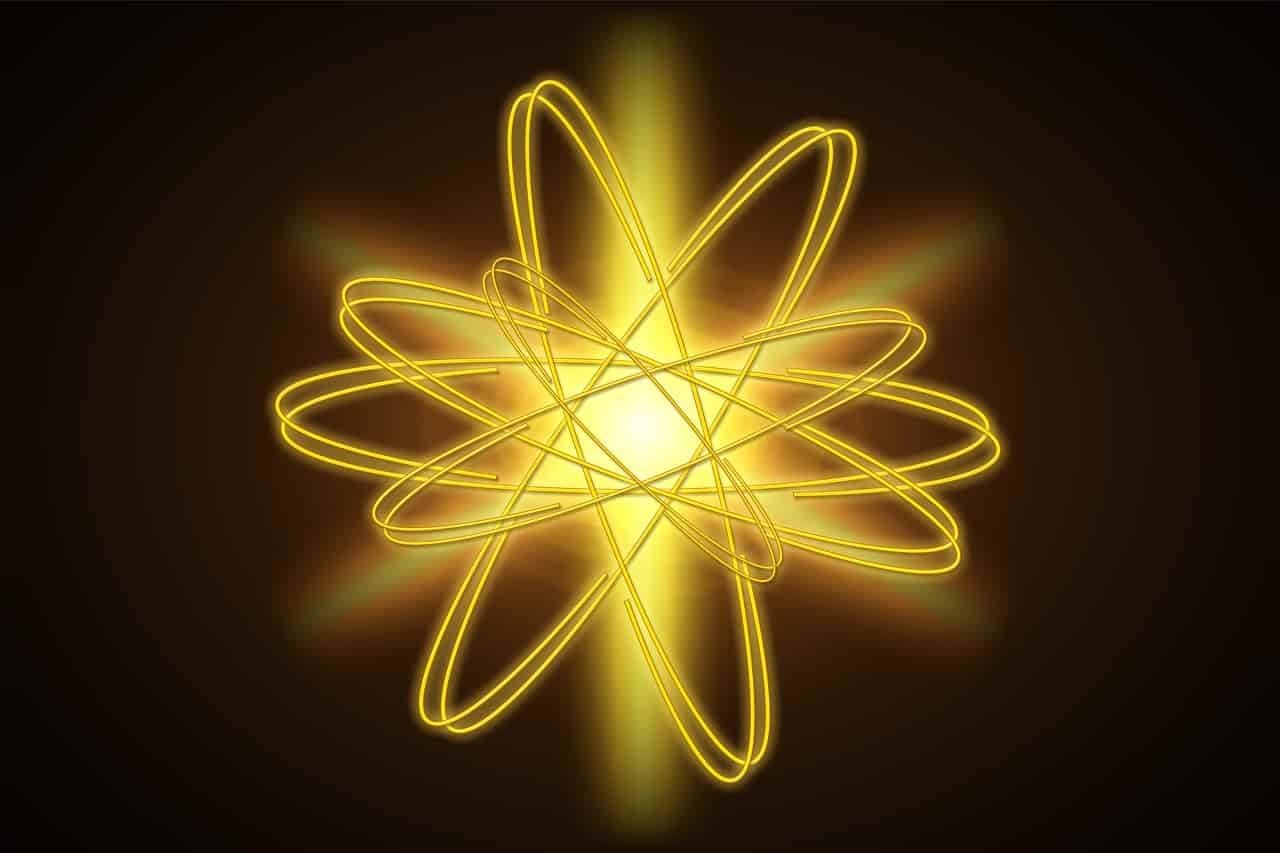Atomic Model
Here are the different types of atomic model: Democritus, Dalton, Thompson, Rutherford, Nagaoka, Bohr, Sommerfeld, Schrodinger and Quantum Mechanics:
1. Democritus
2. Dalton
3. Thomson
4. Nagaoka
5. Rutherford
6. Bohr
7. Sommerfeld
8. Schroedinger
9. Quantum Mechanics
1. Democritos (Philosopher)
It existed in ancient Greek times, around 400 BC. J-C, that the concept of atoms came up with the philosopher Démocrite.
Despite any experimental observations, he hypothesized that matter consisted of indivisible elementary particles that he called atoms.
For Democritus, atoms are eternal and irreversible. He describes the various matter that surrounds us with infinite shapes that atoms can take.
Aristotle’s opposition to this intuition led to the abandonment of the idea of atoms. Therefore, matter remains composed of four “elements”: fire, air, soil, and water.
Like his teacher Leucippus – and deviated from his teacher Parmenides – he postulated in his atomic theory that all nature consists of the smallest invisible and indivisible unit (elementary particle), the atom.
Democritus’ main statement on this is (according to a second-century document by Galenus):
“It seems that only something has a color, it seems to be just sweet or bitter, in fact there are only atoms in the empty space”.
Each of these atoms must be dense and massive, but not the same. There are countless atoms: round, smooth, irregular and bent. When these approach each other, fall together, or intertwine, some appear as water, others as fire, as plants, or as humans.
According to him, the sensory perception and existence of the soul can also be traced back to the atomistic principle, where the soul is composed of soul atoms. When a person dies, these soul atoms scatter and can merge with the new soul that has just been formed. Everything that moves in space is based on chance or necessity. This doctrine is a consistent and atomistic materialism. Essential traits can be found to be almost unchanged among materialistic-minded natural scientists in later periods.
Democritus rejected the assumption of spiritual principles that differed from physical matter, as did his predecessor Anaxagoras. This principle must form something according to its final goal. Instead, Democritus traces the existence of objects back to the inseparable elements of matter, the corporeal atoms. From the very beginning, it has a movement inherent in the void. That is, it traces the changes back to the mechanically acting causes.
2. Dalton Model
According to the modelbya, they are a solid ball that has no charge.
It is the smallest unity that can be divided again. If different chemical elements will have different types as well.
The Democritus hypothesis was taken in 1805 by John Dalton.
According to him, atoms are limited to hard balls, full of matter. It describes chemical reactions as assemblies or rearrangements of atoms.
Dalton’s Law
- It is the smallest piece of matter that cannot be divided.
- It has been described as a very small solid pattern, an element has identical atoms and different to different elements.
- Joined to form compounds with simple comparisons and integers. Like water from hydrogen and oxygen.
- A chemical reaction is the merging or separation or constituent and return of an atom, so that it cannot be destroyed or destroyed.
Advantages of Dalton’s Theory
- Can explain the law of chemical combinations.
- Dalton was the first to acknowledge the existence of applicable differences between particles from an element or atom and from molecules or compounds.
Weaknesses of Dalton’s Theory
- This theory has failed to explain the existence of allotropes. The difference in properties of charcoal, graphite and diamonds cannot be explained because all three are composed of the same atom (carbon).
- From the same element is the same in everything. This statement is incorrect because atoms of different elements are called isotopes. For example, Chlorine has two isotopes that have masses that have mass numbers of 37 and 35 atomic masses.
- Different elements. This is proven wrong in certain cases.
- Different elements have combined in an overall simple number ratio to form compounds. It is not seen in complex compounds e.g. C12H22O11 sugar.
3. Thompson Model
It is a solid sphere that is positively charged with the negative particles (electrons) scattered within it.
Then, the positive and negative charges on the atom are the same. This model has been proven in Thomson’s research that uses cathode tube rays.
J.J. Thomson’s Theory
- In the form of a positively charged ball with negatively charged electrons around it.
- The positive and negative charges on atoms are the same magnitude. This makes it neutral. An atom has no positive charge and excessive negative charge.
Advantages of Thomson Model Theory
- It can explain the existence of particles smaller than atoms called subatomic.
- It can explain the nature of electrical-atoms.
Weaknesses of Thomson Model Theory
- It cannot explain the phenomenon of the blacking of alpha particles by the thin membrane of gold that Rutherford put forward.
- Unable to explain the point.
4. Nagaoka atomic model
In 1904, Hantaro Nagaoka developed an atomic model that complemented Thomson’s atomic model. The Nagaoka model is also known as the atomic model of Saturn.
This atomic model is a hypothetical model of atomic structure unlike Thomson’s raisin pudding model. In this model, the existence of atomic nuclei is postulated for the first time.
What is nagaoka atomic model?
In the early 20th century, after studying Dalton’s atomic model and Thomson’s model, physicists only began to understand the structure of atoms. The discovery of electrons indicates the presence of a negative charge in the atom and that, in order to be globally neutral, it certainly implies that a positive charge also exists.
Nagaoka, based on the fact that the opposite electric charge is impenetrable, proposed an atomic model based on a large massive sphere with a positive electric charge. This sphere is the nucleus of an atom and is surrounded by several electrons orbiting around it. Nagaoka describes this orbit as a circular orbit, on par with Saturn and its rings.
Nagaoka explains atomic stability according to his model by analogy to the stability of Saturn’s rings. James Clerk Maxwell recently published a study of this model and made two predictions:
- the presence of a very massive core, in analogy with the disproportion between the mass of Saturn and the mass of the rings;
- that electrons revolve around the nucleus bound by electrostatic force, just like particles in the ring
- it revolves around the planet bound by the force of gravity.
How did the Nagaoka model affect Rutherford’s atomic model?
Both predictions were quite confirmed by Ernest Rutherford, who mentioned the Nagaoka model in a 1911 paper reporting on the discovery of the nucleus.
However, Rutherford’s atomic model reveals just how wrong the Saturn model is. In reality, the point is much smaller than Nagaoka expected. In addition, the electrically charged ring will not be stable against oscillations in the orthogonal direction to the rotational plane of the ring.
Read also: Photon is Boson with γ (gamma) Symbol in Physics
Rutherford’s discovery would form the basis of studies for developing niels bohr atomic models and later the Sommerfeld atomic model.
It should also be said that Nagaoka through the Saturn model cannot predict spectrographic phenomena, such as spectral line formation and radioactivity. After this new discovery, Nagaoka himself abandoned his model in 1908.
5. Rutherford Model
Rutherford’s model was proposed by Ernest Rutherford in 1911. In this theory, each atom has a positively charged nucleus in the electrons that surround it.
Its mass is centered on its atomic nucleus and most of the volume of this atom is a vacuum, as it has been proven from the results of metal firing experiments from alpha rays, already known as the Geiger-Marsden Experiment.
Characteristics of Rutherford’s Theory
- Most of them are empty or hollow surfaces.
- It has a positively charged core that is the center of its mass.
- Electrons move around the nucleus at very high speeds.
- Most α (alpha) particles pass by without experiencing deflection. A small part is deflected, and very little is reflected.
- Electron clouds do not affect the spread of α (alpha) particles.
Advantages of rutherford model
- It is easy to understand to explain its complicated structure.
- It can explain the shape of the trajectory of electrons surrounding its nucleus.
- It can describe the motion of electrons around the nucleus.
Rutherford Model Weaknesses
- According to the laws of classical physics, electrons moving around the nucleus emit energy in the form of electromagnetic waves. As a result, over time the electron will run out of energy and eventually attach to the nucleus.
- Rutherford’s model has not been able to explain where electrons lie and how they rotate to their nuclei.
- Electrons emit energy when moving, so their energy becomes unstable.
- It cannot explain the spectrum of lines on hydrogen atoms (H).
6. Bohr Model
Bohr’s model was proposed by Niels Bohr and Ernest Rutherford in 1913. That they consist based on their nuclei containing protons and neutrons is then surrounded by electrons rotating in their orbit (a certain energy level). Orbits are also known as atomic shells.
Advantages of Bohr Theory
Consisting of several shells / subshells for the place of movement of electrons and atoms form an orbit where the nucleus is positive and around it there are electrons.
Weaknesses of Bohr’s Theory
- It is only able to explain the hydrogen spectrum but is unable to explain its more complex spectrum (with a greater number of electrons).
- The orbit / electron shell around the nucleus is not circular but elliptical.
- Bohr regarded electrons only as particles rather than as particles and waves, so the position of electrons in atoms was a naturality.
7. Sommerfeld (extension of bohr model)
The Sommerfeld atomic model is an extension of the Bohr atomic model. The new model was developed by German physicist Arnold Sommerfeld and his assistant Peter Debye in 1916. The model was created using Albert Einstein’s theory of relativity. Sommerfeld discovered that the electrons of certain atoms reach speeds close to the speed of light.
The basic modifications of the Sommerfil model compared to Borr are:
- Electrons move around the nucleus of an atom, in a circular or elliptical orbit.
- Of the second energy level, there are one or more sublevels at the same level.
- Electrons are small electric currents.
- The current atomic model, known as the atomic orbital model, could not have been formulated without an earlier model derived from Bohr’s assumptions.
What are the limitations of bohr’s atomic model?
Bohr’s atomic model is seamless in terms of hydrogen atoms. On the other hand, when it comes to atoms of other chemical elements, electrons with the same energy level have different energies.
For hydrogen atoms and He+ ions, this does not affect the spectrum, since both skin types have the same energy. However, for multi-electron atoms, the amount of energy level that may increase. In the spectrum, this is manifested by more spectral lines.
What is Sommerfeld’s solution to the limitations of the Bohr model?
Regarding this crack, Sommerfeld postulated that in the same energy level there are sub-levels, with slightly different energies. In addition, from theoretical calculations, Sommerfeld has found that in some atoms the speed of electrons reaches a considerable fraction of the speed of light. Sommerfeld also performed this calculation for relativistic electrons.
Sommerfeld’s atomic model introduced two basic modifications:
- Relativistic speed.
In atoms, electrons move in circular and elliptical orbits unlike niels bohr’s model where electrons only rotate in a circular orbit. - The eccentricity of orbits has given rise to a new quantum number that determines the shape of orbitals: quantum numbers azimuths.
When drawing, the main quantum number n = n’ + k. The secondary quantum number n’ determines the angular (radial) momentum and eccentricity of the elliptical. For n’=0 a circular orbit appears. The lateral quantum number k describes the angular momentum that hydrogen electrons can take.
What is the Wilson-Sommerfeld formula?
The Wilson-Sommerfeld formula represents a key element for the Bohr-Sommerfeld model definition.
In this model, electrons are supposed to travel around the nucleus in an elliptical orbit, unlike Bohr’s original model in which they traveled in a circular orbit.
The Bohr-Sommerfeld model envisages additional quantization restrictions on electron angular momentum quantization with additional restrictions on radius quantization determined by the “Wilson-Sommerfeld quantization restriction formula”:

Where is p Does the moment dq represent the differential of the generic coordinate function q(t) and n is the natural number and h is Planck’s constant.
8. Schrodinger atomic model
Schrödinger’s atomic model was developed in 1926 after the debut of Louis de Broglie’s wave mechanics. It is a model of atomic quantum mechanics that starts with schrödiger’s equation. In 1926, Erwin Schrödinger developed this equation to determine the probability of finding an electron at a certain point in an atom.
Until then, electrons were only thought to rotate in a circular orbit around the nucleus of an atom according to Bohr’s atomic model. Schrödinger claimed that electrons, which define them as small spheres, can also rotate in more complex elliptical orbits and calculate relativistic effects.
Schrödinger’s wave equation solution is also called the wave function. The wave function is a mathematical function that only provides an opportunity to find electrons at a certain point around the nucleus.
What are the limitations of the Bohr atomic model?
Until 1932, it was believed that atoms consisted of positively charged nuclei surrounded by negatively charged electrons.
Bohr’s model worked for hydrogen atoms. However, when that model was applied to other atoms, it was observed that electrons with the same energy level differ slightly especially if the atomic number is high.
This variation cannot be explained in the Niels Bohr model and therefore some correction is required. The proposition is that in the same energy level there are sub-levels. The concrete way these sub-levels arise naturally is by combining elliptical orbits and relativistic corrections.
In 1932, James Chadwick bombarded beryllium atoms with alpha particles. Unknown radiation is emitted. These particles are neutrons and their discovery brings scientists closer to a more precise model of the atom.
What is the difference between Schrödinger and Bohr’s atomic models?
Bohr’s atomic model established the exact path for each electron in the atom. However, quantum mechanics models only predict the probability of electron position.
To solve the Schrödinger equation, it is necessary to quantify the energy of electrons. On the other hand, in Bohr’s model, these quantum numbers are considered to have no mathematical basis.
Features of The Current Atomic Model
Schrödinger’s atomic model originally thought of electrons as waves of matter. So schrödinger’s equation describes the evolution in time and space of the material wave.
Later, Max Born proposed a probabilistic interpretation of the electron wave function. However, this interpretation is a probabilistic model that allows empirical predictions to be made, but in which position and momentum cannot be known simultaneously, due to the uncertainty principle.
Schrödinger’s atomic model can be represented as a cloud of electrons surrounding the nucleus of an atom representing the density of possible presence. In places where these clouds are most dense, the chances of finding electrons are greater. Therefore, this model introduces the concept of energy sublevel.
For ease of understanding, we will consider the simplest atoms to show some diagrams that reveal the basic points of the model:
- The electron cloud is associated with the basic state, which indicates the possible presence of electrons in the nucleus. This possibility involves the capture of electrons in nuclear physics.
- Awan elektron terikat pada kombinasi linier dari dua orbital yang terkait dengan tingkat tereksitasi pertama. Dalam hal ini, kita dapat melihat kemungkinan adanya awan elektron di luar atom yang memungkinkan terjadinya ikatan molekul.
- Awan ini dijelaskan secara khusus oleh harmonik bola. Bentuk paling sederhana dari awan elektronik ini adalah simetri bola. (r, , ) adalah kerapatan peluang untuk menemukan elektron pada koordinat bola (r, , ).
Apa yang diprediksi oleh model atom Schrödinger?
Model atom Schrödinger memprediksi:
- Garis emisi spektral atom netral dan terionisasi.
- Changes in energy levels when there is a magnetic or electric field.
- In addition, with some semi-heuristic modifications, the model describes the chemical bonding and molecular stability.
What’s wrong with quantum mechanical atomic models?
Schrödinger’s model is incomplete on the following points:
- It does not take into account the spin of electrons.
- The model ignores the relativistic effect of fast electrons.
- Schrödinger’s model does not explain why electrons in an excited quantum state decay to a lower level if there is a free electron (free electron: An electron that has been broken free from that atomic bond and is therefore not bound to the atom).
9. Atomic Model of Quantum Mechanics
It consists based on its positively charged core and the electron clouds that surround it. The region where electrons are found is named orbital. According to this theory, there are four types of orbitals namely s, p, d, f.
Introduction to the quantum model of atoms: associate the probability density of presence with electrons in the form of wave functions using the wavelength de Broglie, schrödinger equation and Heisenberg uncertainty principle. Electron spin and the Stern-Gerlach experiment.
Sources: PinterPandai, Britannica, StudySmarter, LibreTexts
Photo credit: Geralt / Pixabay (Pixabay License: Free for commercial use, No attribution required)



